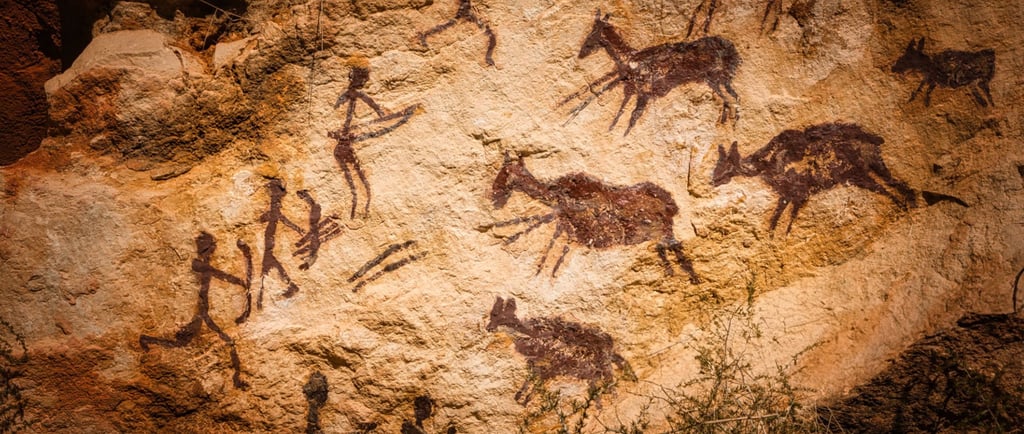🏹 The Bow and Arrow — The Invention of Survival 💡
🏹 A follow-up story that birdges between the Chapters: Early Human Beings, Fundamental Needs and Ways of Life, Types of Societies and Social Revolutions, Inventions and Discovery, and Migrations in the History Album. 🧠🪵 It invites children to trace the invisible thread between early human survival and the power of invention—through the evolution of the bow and arrow. 🏹 From the earliest tool-making humans to the growing awareness of Fundamental Needs , children begin to understand that the drive to eat, protect, and create is universal. In this story the bow reappears—not just as a hunting tool, but as a revolutionary invention that reshaped societies. We discover together how archery becomes part of human migration, culture, and even resistance. This story awakens the same forces found in every child: the tendency to observe, experiment, and imagine. It invites them to wonder: “What other tools have people invented by watching and experimenting with nature?” 🌍🏹💡
HISTORY STORIES
5/10/20254 min read


Over 60,000 years ago… Long before there were cities 🏙️, cars 🚗, or even written words ✍️… Long before anyone carved letters into stone or inked scrolls by candlelight 🕯️…Long before all the inventions around us… Our ancestors were already exploring the Earth.🌍
They walked through forests🌲, crossed rivers 🌊, and climbed rocky hills 🪨. They built homes from what they found—caves, sticks, leaves, and animal skins 🛖. Life was beautiful—but also hard. 🌳
They couldn’t go to the store to buy dinner. 🍽️ They had to hunt for food. To survive, they needed to catch deer 🦌, rabbits 🐇, and birds 🐦—but those animals were quick and clever.
At first, people threw long wooden spears 🪵, sometimes with heavy stone tips. They used their strength to hurl them toward animals. Later, they invented the atlatl (pronounced aht-laht-l ) —a special stick that helped them throw the spear even farther, like a powerful lever. 🪃 The name atlatl comes from the language of the Aztecs—people who lived in what is now Mexico 🇲🇽. It was their word for a spear-thrower.
But spears were still heavy and hard to aim. People began to wonder: What if there was a way to send a lighter tool—faster, farther, and more quietly? That’s when people noticed something special in nature: Some branches could bend without breaking. 🌿They took one of those bendy branches and tied a rope made from bark or twisted reeds between the ends. Then they carved small arrows—straight sticks with sharp tips—and pulled the rope back…
🌀 The arrow flew through the air! WHOOSH! And this was the birth of the bow and arrow. 🏹
At first, the designs were simple. But over time —across many generations 🌍people in different parts of the world, began to experiment and improve.
They tried different types of wood 🌲, noticed how the shape of the bow affected the strength of the shot, and tested new string materials—like sinew from animals or twisted plant fibers. 🧵 Sinew is a strong fiber from inside animals. It’s part of their body that helps muscles pull bones. When dried, it made a stretchy, tough string—perfect for bow-making and sewing.
Eventually, someone discovered that if you added feathers to the back of the arrow, it would spin as it flew—making it straighter and faster. 🪶 Each small improvement made the bow more accurate 🎯, more powerful 💥 , and easier to use.
Arrowheads were made from stone, bone, metal—first bronze 🟫, then iron ⚙️.
🌏People all over the world developed their own styles of bows and arrows—each one shaped by the land, the animals, and the needs of the people who used them.
In the north ❄️, people used short bows made from bone and sinew.
In Asia 🌄, the Mongols made curved composite bows for shooting on horseback 🐎
In England 🇬🇧 , people crafted the longbow that could shoot very far
In North America 🇺🇸, Native Americans made beautiful wooden bows, decorated with natural dyes and feathers 🌾
The bow and arrow wasn’t just a tool. It became a symbol of human creativity problem-solving, and intelligence. Here some examples of Historical Bows
🤔I wonder… How the bow and arrow changed the diet of early humans. 🍗🌽 If people still hunt with bows today— where and what they hunt? Is it allowed to go out and start hunting? 🏹🦌
How people in different parts of the world improved archery over time. 🌍
How archery became a sport, and how it entered the Olympics 🏅.
Which trees 🌳 are best for making bows—and which ones are best for arrows 🪵.
🛠️✨ Possible Follow-Up Explorations :
🌳🔍The Best Tree for a Bow
Would you like to discover which tree makes the best bow? What kind of wood bends without breaking? Can you design your own bow and arrow using natural materials?
🔍 Research, observe, experiment—just like the first inventors. Create your own bow. 🏹 Test different arrows—with feathers and without—and compare your designs. 📝 Record your findings: Which shot farther? Which was easier to aim?
🏹📚 Types of Bows Across Time
Did you know there are many kinds of bows—each designed by people in different times and places to meet different needs? 🗺️ Can you create a map or timeline showing where each bow was used and for what?
Short bows — used in dense forests for close-range hunting
Longbows — tall and powerful, famously used in medieval England 🇬🇧
Composite bows — made of layered materials like wood, horn, and sinew; used by horse-riding warriors like the Mongols 🐎
Recurve bows — with curved limbs that add power to the shot
Flatbows — used by Indigenous peoples of North America, shaped for balance and ease
Crossbows — invented in ancient China and used widely in medieval Europe 🏰; a mechanical advancement that allowed someone to load and shoot with less effort but great force
🏷️🔍Naming Every Part: The Language of the Bow and Arrow
People have always been curious—not just about how things work, but about what to call them. And just like we name the parts of a leaf, a sentence, or the Earth, people gave names to every single part of the bow and arrow. Why? Because naming helps us understand, talk about, and improve things. People being people, they couldn’t help but organize and name what they loved and used every day. Maybe you can research, draw and label your own diagram of bow and arrow.
Addition to my friends from Montessori Israel Leadership Assosiation - MillA
📖 But this tool also tells another kind of story…
A long time later, during the time of the Roman Empire 🏛️, people lived in towns and cities. The Romans ruled over many lands—including the land where the Jewish people lived.
At that time, the Romans made a strict rule: “No one is allowed to study the Torah.”
The Torah 📜 is full of stories 📖, teachings 🧠, and questions ❓ about life. It was a treasure to the Jewish people—something to pass on from generation to generation.
But now, learning it was dangerous ⚠️.
Still… the people didn’t give up. Especially the young ones. 🧒👦🏽👧🏻
They came up with a clever plan. They would take their bows and arrows and head into the forest.🌳 If the Roman guards saw them, they would say: “We’re just going hunting!”
But hidden under their cloaks were scrolls📜 and small handwritten texts.
In the quiet woods 🌲, they gathered together. They found clearings beneath the trees and unrolled the parchment. There, with the sun flickering through the leaves, they read in whispers—words that had been passed down for centuries.🌞🍃
📚 They didn’t just protect their bodies…
They protected their spirit✡️, their identity 🧬, and their right to learn 🧠.
The bow and arrow became more than a hunting tool.
It became a shield for knowledge, and a quiet guardian of learning.
With Montessori joy,
Vanina 😊

